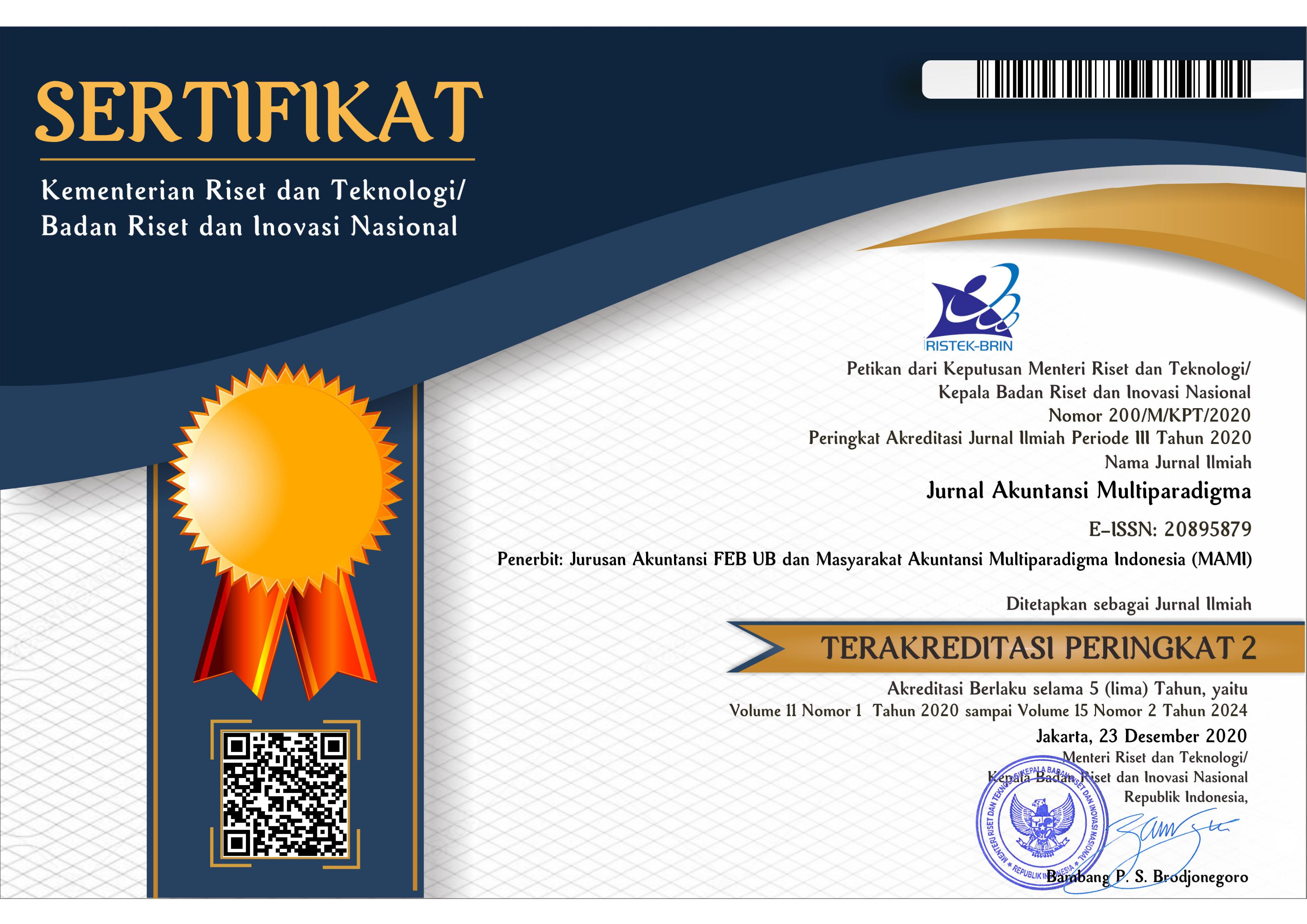HOW DOES LOCAL WISDOM BECOME VALUE IN SELLING-PRICE SETTING?
Abstract
Abstrak – Bagaimana Kearifan Lokal Menjadi Nilai Utama dari Penentuan Harga Jual?
Tujuan Utama – Penelitian ini mencoba menggali makna penentuan harga jual dari perspektif pedagang ikan.
Metode - Penelitian ini menggunakan fenomenologi sebagai metode penelitian. Beberapa pedagang ikan dan kepala pasar menjadi informan pada penelitian ini.
Temuan Utama – Penelitian menunjukkan bahwa Pedagang ikan cenderung mengabaikan perhitungan harga pokok penjualan (HPP). Nilai kepercayaan dan sipammase-mase yang terkandung pada HPP dijadikan dasar untuk menentukan harga jual ikan. Harga jual terkonsep sebagai “rasa” saling mengasihi terhadap sesama.
Implikasi Teori dan Kebijakan - Beberapa aspek non-materi yang mendasari pengabaian HPP. Rasa syukur yang tersirat menggambarkan pengabaian aspek biaya dalam HPP untuk menentukan harga jual.
Kebaruan Penelitian – Penggalian nilai nonmateri dalam penentuan harga jual dari pedagang ikan merupakan kebaruan utama dari penelitian ini.
Abstract – How Does Local Wisdom Become Value in Selling-Price Setting??
Main Purpose – This study tried to explore the meaning of selling price determination from the perspective of fish traders.
Method - This study uses phenomenology as a research method. Several fish traders and market chiefs became informants on the study.
Main Findings – This study shows that fish traders tend to ignore the calculation of the cost of goods sold (COGS). The value of trust and Sipammase-mase contained in COGS is used as a basis for determining the selling price of fish. The selling price is conceptualized as a "sense" of loving each other towards each other.
Theory and Practical Implications – Some of the non-material aspects underlying COGS abandonment. Implied gratitude describes the abandonment of the cost aspect in COGS to determine the selling price.
Novelty - Extracting nonmatter value in determining the selling price of fish traders is a major main of this study.
Keywords
Full Text:
PDFReferences
Alimuddin, I, Triyuwono, G, Irianto, & Chandrarin, G. (2011). Konsep Harga Jual Kejujuran: Meraih Keuntungan Menggapai Kemaslahatan. Jurnal Akuntansi Multiparadigma, 2(1), 70–90. https://doi.org/https://doi.org/10.18202/jamal.2011.04.7111
Amaliah, T. H. (2016). Nilai-Nilai Budaya Tri Hita Karana dalam Penetapan Harga Jual. Jurnal Akuntansi Multiparadigma, 7(2), 189–206. https://doi.org/10.18202/jamal.2016.08.7016
Amaliah, T. H., & Sugianto, S. (2018). Konsep Harga Jual Betawian dalam Bingkai Si Pitung. Jurnal Akuntansi Multiparadigma, 9(1), 20–37. https://doi.org/10.18202/jamal.2018.04.9002
Ammar, S. (2017). Enterprise Systems, Business Process Management and UK-Management Accounting Practices: Cross- Sectional Case Studies. Qualitative Research in Accounting and Management, 14(3), 230-281. https://doi.org/10.118/QRAM-05-2016-0044
Arndt, A. D., Rippe, C. B., & Castleberry, S. B. (2018). Any Question? Questioning Skill as a Selling Tactic for Sales Students. Journal for Advancement of Marketing Education, 26(2), 1-9.
Attas, S. G. (2017). Seni Pertunjukan Cerita Si Pitung: Pertarungan Identitas dan Representasi Budaya Betawi. Arkhais - Jurnal Ilmu Bahasa dan Sastra Indonesia, 8(1), 70–80. https://doi.org/10.21009/arkhais.081.08
Badua, F., & Racca, J. C. (2017). Pacioli, Profit, and Positivism: How Inherited Professional and Academic Traditions Have Stymied Accounting Scholarship. Accounting Historians Journal, 44(2), 99–108. https://doi.org/10.2308/aahj10- 535
Brown, J., & Jones, M. (2015). Mapping and Exploring the Topography of Contemporary Financial Accounting Research. The British Accounting Review, 47(3), 237–261. https://doi.org/https://doi.org/10.1016/j. bar.2014.08.006
Budiasih, I. G. A. N. (2016). Social and Environment Accounting Practices at the Time of the Ancient Bali. Procedia Social and Behavioral Sciences, 219, 145-151. https://doi.org/https://doi.org/10.1016/j.sbspro.2016 .04.056
Carter, W. (2011). Akuntansi Biaya. Salemba Empat.
Conklin, T. A. (2014). Phenomenology redux: Doing Phenomenology, Becoming Phenomenological. Organisation Management Journal, 11(2), 116–128. https://doi.org/10.1080/15416518.2014.929935
Covaleski, M., & Dirsmith, M. W. (1998). The Use of Budgetary Symbols in the Political Arena: An historically Informed Field Study. Accounting, Organizations and Society, 13(3), 1–24. https://doi.org/10.1016/0361-3682(88)90023-2
González-Benito, Ó., Martínez-Ruiz, M. P., & Mollá-Descals, A. (2010). Retail Pricing Decisions and Product Category Competitive Structure. Decision Support Systems, 49(1), 110–119. https://doi.org/10.1016/j.dss.2010.01.009
Hardesty, D. M., Bearden, W. O., Haws, K. L., & Kidwell, B. (2012). Enhancing Perceptions of Price-Value Associated with Price-Matching Guarantees. Journal of Business Research, 65(8), 1096–1101. https://doi.org/10.1016/j.jbusres.2011.08.024
Hidayat, S., & Triyuwono, I. (2019). Praktik Penentuan Harga Jual Berbasis Meuramin. Jurnal Akuntansi Multiparadigma, 10(1), 42–62. https://doi.org/https://doi.org/10.18202/jamal.2019.04.10003
Hopper, T. (2017). Neopatrimonialism, Good Governance, Corruption and Accounting in Africa: Idealism vs Pragmatism. Journal of Accounting in Emerging Economies, 7(2), 225–248. https://doi.org/https://doi.org/10.1108/JAEE-12-2015-0086
Inada, S., & Ichikizaki, O. (2019) Safety Analysis of Manufacturing Investment Alternatives Under Uncertainty of Product Selling Price, Sales Volume and Market Life. Journal of Japan Industrial Management Association, 70(2), 62-70. https://doi.org/10.11221/jima.70.62
Indrayani, H., & Harkaneri, H. (2019). Implementasi Sistem Bagi Hasil pada Perkebunan Karet Rakyat Masyarakat Kabupaten Kampar Riau. Jurnal Al-Iqtishad, 14(2), 41-62. https://doi.org/10.24014/jiq.v14i2.6810
Kamayanti, A. (2016). Metodologi Penelitian Kualitatif Akuntansi Pengantar Religiositas Keilmuan. Yayasan Rumah Peneleh.
Kusdewanti, A. I., Triyuwono, I., & Djamhuri, A. (2016). Teori Ketundukan: Gugatan terhadap Agency Theory. Yayasan Rumah Peneleh.
Marginson, D. E. W. (2004). The Case Study, The Interview and the Issue: A Personal Reflection. The Real Life Guide to Accounting Research, 19(3), 257–279. https://doi.org/10.1016/b978-008043972-3/50017-7
Mulawarman, A., & Kamayanti, A. (2018). Towards Islamic Accounting Anthropology: how secular anthropology reshaped accounting in Indonesia. Journal of Islamic Accounting and Business Research, 9(4), 629-647. https://doi.org/10.1108/ JIABR-02-2015-0004
Ndemewah, S., Manges, K., & Hiebl, M. (2019). Management Accounting Research on Farms: What is Known and What Needs Knowing? Journal of Accounting & Organizational Change, 15(1), 58–86. https://doi.org/10.1108/JAOC-05-2018-0044
Pal, B., Sana, S. S., & Chaudhuri, K. (2012). Multi-item EOQ Model While Demand is Sales Price and Price Break Sensitive. Economic Modelling, 29(6), 2283–2288. https://doi.org/10.1016/j.econmod.2012.06.039
Putra, C., & Muliati, N. (2020). Spirit Kearifan Lokal Bali dalam Akuntabilitas Desa Adat. Jurnal Akuntansi Multiparadigma, 11(3), 561–580. https://doi.org/10.21776/ub.jamal.2020.11.3.32
Rahayu, S., Yudi, & Sari, D. P. (2016). Makna Biaya pada Ritual Ngaturang Canang Masyarakat Bali. Jurnal Akuntansi Multiparadigma, 388–404. https://doi.org/10.18202/jamal.2016.12.7028
Rahmawati, & Yusuf, M. (2020). Budaya Sipallambi’ Dalam Praktik Bagi Hasil. Jurnal Akuntansi Multiparadigma, 11(2), 386–401. https://doi.org/10.21776/ub.jamal.2020.11.2.23
Rahyuda, I., Purbawangsa, I. B. A., & Surya, I. B. K. (2019). Relationship Between Competitive SMEs’ Orientation and “Catur Paramitha.” International Journal of Social Economics, 46(7), 861–873. https://doi.org/10.1108/IJSE-01-2019-0004
Sami, A., & Nafik, H. (2014). Dampak Shadaqah pada Keberlangsungan Usaha. Jurnal Ekonomi Syariah Teori dan Terapan, 1(3), 205–220. https://doi.org/10.20473/vol1iss20143pp205-220
Sanders, P. (1982). Phenomenology: A New Way of Viewing Organixational Research. The Academy of Management Reveiw, 7(3), 353–360. https://doi.org/10.5465/amr.1982.4285315
Shallehuddin, B. (2016). Spritual Capital Rahasia Sukses Raih Rezeki Berkah Melimpah. Gramedia Pustaka Utama.
Sitorus, J. H. E. (2015). Membawa Pancasila dalam Suatu Definisi Akuntansi. Jurnal Akuntansi Multiparadigma, 6(2), 254-271. https://doi.org/10.18202/jamal.2015.08.6021
Soonthornchai, P. (2017). Financial Management Using Moderate Capitalism for Dairy Cow Farms in Maha Sarakham Province, Thailand. International Journal of Trade and Global Markets, 10(1), 13–18. https://doi.org/https://doi.org/10.1504/IJT- GM.2017.082369
Suryani, N. K., Budiasih, I. G. A. N., Sudana, I. P., & Wirajaya, I. G. A. (2021). Menguak Konsep Harga dan Laba di Balik Transaksi Banten. Jurnal Akuntansi Multiparadigma, 12 (2), 370-387. http://doi.org/10.217761/ub.jamal.2021.12.2.2021
Syahyuti, N. (2016). Nilai-Nilai Kearifan pada Konsep Penguasaan Tanah Menurut Hukum Adat di Indonesia. Forum Penelitian Agro Ekonomi, 24(1), 14-27. https://doi.org/10.21082/fae.v24n1.2006.14-27
Tanasal, S., Randa, F., & Ng, S. (2019). Akuntabilitas Berbasis Mettā dan Kamma. Jurnal Akuntansi Multiparadigma, 10(3), 448–467. https://doi.org/10.21776/ub.jamal.2019.10.3.26
Utomo, T., & Utomo, C. (2014). Penetapan Harga Pokok Penjualan Berdasarkan Alokasi Biaya Terhadap Posisi Rumah Pada Perumahan Green Park Residence Sampang. Jurnal Teknik Pomits, 3(2), 76–80. https://doi.org/10.12962/j23373539.v3i2.7018
Weretecki, P., Greve, G., & Henseler, J. (2021). Selling Actors in Multi-Actors Sales Ecosystems: EHo They Are, What They Do, and Why It Matters. Journal of Business and Industrial Marketing, 36(4), 641-653. http://doi.org/10.1108/JNIM-03-2020-0145
Yusof, R. M., Bahlous, M., & Tursunov, H. (2015). Are Profit Sharing Rates of Mudharabah Account Linked to Interest Rates? An Investigation on Islamic Banks in GCC Countries. Jurnal Ekonomi Malaysia, 49(2), 77–86. https://doi.org/10.17576/JEM-2015-4902-07
Zalshabila, S., & Mulawarman. (2012). Javanese Price Setting: Refleksi Fenomenologis Harga Pokok Produksi Pedagang Bakso di Kota Malang. Jurnal Akuntansi Multiparadigma, 3(2), 161–333. https://doi.org/10.18202/jamal.2012.08.7152
DOI: http://dx.doi.org/10.21776/ub.jamal.2021.12.3.38
Refbacks
- There are currently no refbacks.
Copyright (c) 2021 Antong, Riyanti

This work is licensed under a Creative Commons Attribution-NonCommercial 4.0 International License.

















